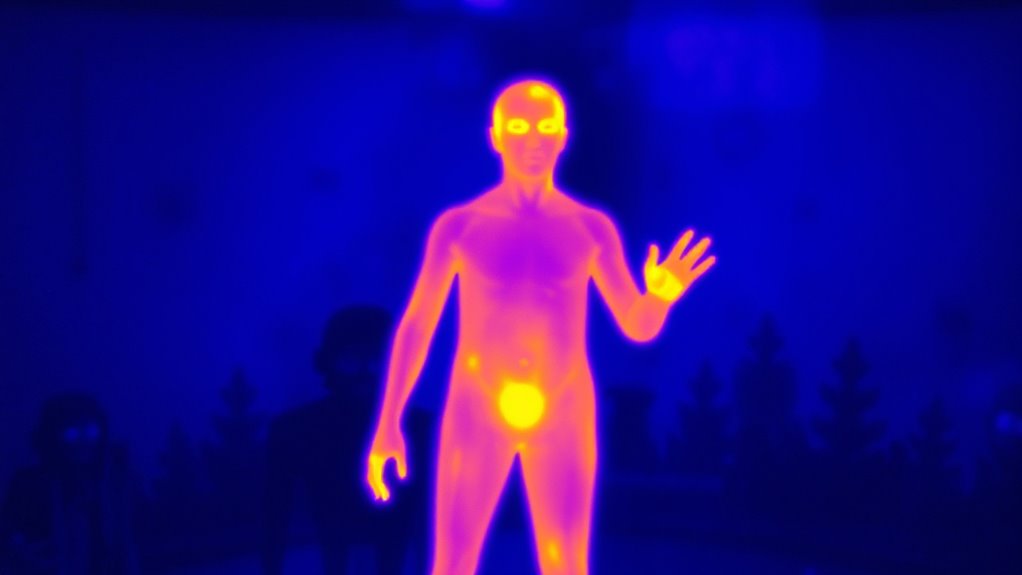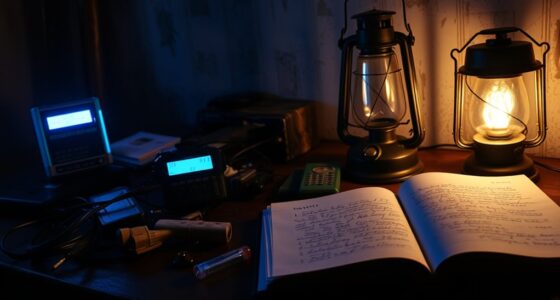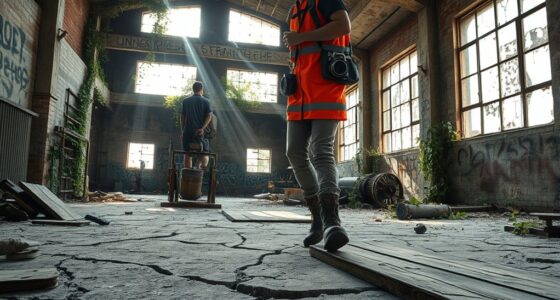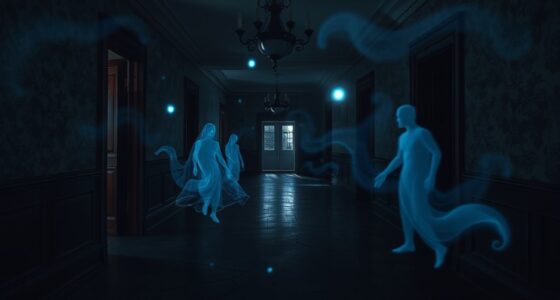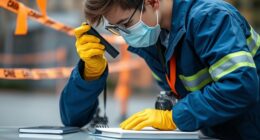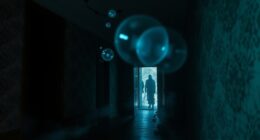Thermal imaging captures heat signatures that can indicate supernatural presence during investigations. When you use infrared technology, you might see unusual cold spots or unexpected heat anomalies, which could suggest a ghostly entity. These signatures often reveal hidden activity in dark or obstructed areas. By analyzing these temperature variations carefully, you can differentiate natural causes from potential paranormal influences. Continue exploring to discover how these thermal clues can help uncover the mysteries lurking in shadows.
Key Takeaways
- Ghostly heat signatures may appear as unusual warmth or cold spots detected by thermal imaging.
- Paranormal activity often manifests as irregular temperature anomalies inconsistent with environmental factors.
- Cold spots are common indicators of potential spectral presence, visible as sudden temperature drops.
- Proper analysis requires ruling out natural causes like drafts, leaks, or equipment malfunctions.
- Interpreting heat signatures accurately aids in distinguishing genuine paranormal phenomena from mundane explanations.
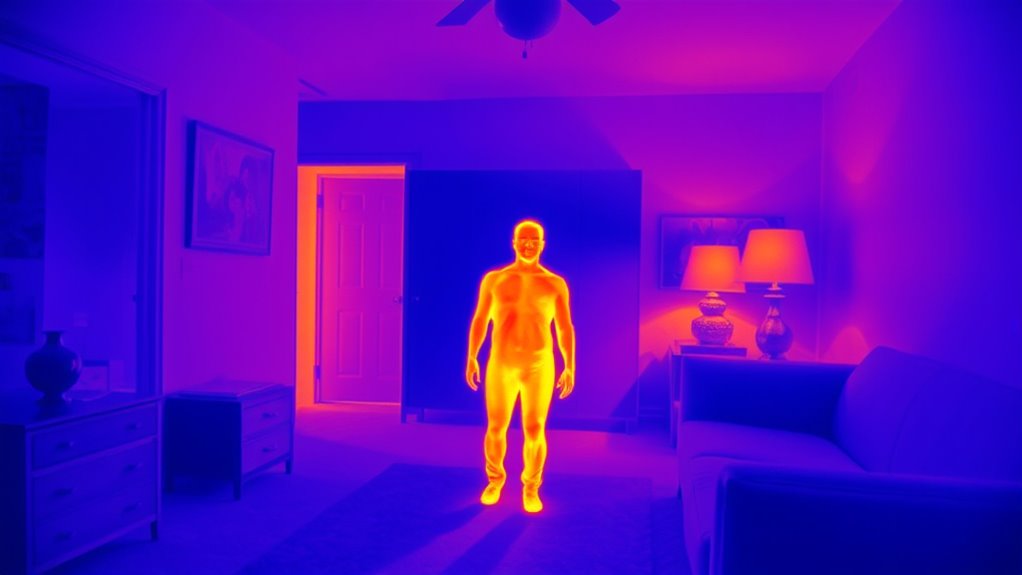
Have you ever wondered how investigators detect hidden clues or locate suspects in complete darkness? One of the most innovative tools they use is thermal imaging, which relies on infrared technology to visualize heat signatures that are invisible to the naked eye. This technology captures the thermal radiation emitted by objects and living beings, creating images based on temperature differences. It’s especially useful in situations where traditional lighting won’t cut it or might alter the scene. By detecting minute variations in heat, investigators can uncover evidence that would otherwise stay hidden.
Infrared technology is the backbone of thermal imaging devices, allowing them to detect even subtle temperature changes. This capability is essential when exploring environments where visibility is compromised, such as dark rooms, dense forests, or abandoned buildings. When it comes to investigating ghostly phenomena, thermal imaging can sometimes reveal anomalies that might be interpreted as supernatural activity. These anomalies often appear as unusual heat signatures, which could be caused by the presence of a living person, a lingering source of warmth, or even unexplained cold spots.
Cold spot analysis is a key aspect of thermal investigations, especially when it comes to paranormal research. Cold spots are areas where the temperature drops markedly, and these can be captured visually through thermal imaging. Some believe that cold spots indicate the presence of spirits or other supernatural entities, as they often seem to coincide with reports of paranormal activity. In an investigative context, spotting a cold spot involves comparing thermal images over time and looking for sudden, unexplained changes in temperature that don’t have an obvious physical cause.
Using infrared technology and cold spot analysis, investigators can differentiate between natural causes of temperature variation—like drafts, leaks, or environmental factors—and potential paranormal phenomena. This process involves careful calibration and analysis, ensuring that what’s seen isn’t just a result of equipment error or environmental conditions. When you’re conducting a thermal investigation, understanding how to interpret these heat signatures is vital. Not every cold spot signifies something supernatural; many are explained by mundane factors. However, when cold spots appear in areas where no drafts or environmental explanations exist, they become intriguing clues.
Frequently Asked Questions
Can Thermal Imaging Detect Non-Physical Paranormal Entities?
You wonder if thermal imaging can detect non-physical paranormal entities. While thermal energy might produce visual anomalies, it doesn’t definitively identify spirits. These devices detect temperature differences, but paranormal entities aren’t proven to emit or influence heat. So, seeing anomalies on thermal images could suggest something unusual, but you can’t conclusively attribute them to non-physical entities. They remain intriguing clues, not proof, of paranormal presence.
How Reliable Is Thermal Imaging Compared to Other Ghost Detection Methods?
You might wonder how reliable thermal imaging is for ghost detection compared to other methods. While it can reveal unusual heat signatures that suggest paranormal activity, thermal imaging isn’t foolproof. It’s often less reliable than EVPs or spirit boxes, which capture auditory clues. However, combining thermal imaging with other ghost detection techniques increases your chances of confirming paranormal presence, making it a valuable tool in your investigation toolkit.
Are There Specific Environmental Conditions That Affect Thermal Imaging Accuracy?
Imagine chasing elusive truths, but environmental factors can cloud your vision. You should know that ambient temperature and humidity effects can markedly impact thermal imaging accuracy. High humidity may obscure heat signatures, while fluctuating ambient temperatures can create false positives or hide subtle signals. Staying aware of these conditions helps you interpret thermal images more reliably, ensuring your investigations remain focused despite nature’s unpredictable influence.
What Are the Limitations of Thermal Imaging in Ghost Investigations?
You should know that thermal imaging has limitations in ghost investigations. Sensor limitations can affect accuracy, especially in detecting subtle temperature changes. False positives are common, as environmental factors like drafts or heat sources might mimic ghostly heat signatures. Relying solely on thermal images can be misleading, so always corroborate findings with other evidence. Understanding these constraints helps you interpret thermal data more effectively during investigations.
Has Thermal Imaging Ever Conclusively Proven a Paranormal Presence?
You wonder if thermal imaging has ever conclusively proved a paranormal presence. While thermal anomalies can suggest unusual activity, they often lead to false positives caused by drafts or equipment issues. Currently, there’s no definitive evidence from thermal imaging alone that confirms a ghost. Instead, it remains a useful tool for gathering clues, but you should combine it with other methods to strengthen your investigation.
Conclusion
By now, you see how thermal imaging has become a crucial tool in investigations, revealing hidden heat signatures others can’t see. Did you know that over 70% of paranormal investigations report thermal anomalies as essential evidence? This technology not only uncovers unseen activity but also adds credibility to your findings. So, next time you’re exploring the unknown, remember that a simple thermal camera might be your best chance to catch a ghost’s subtle presence.
